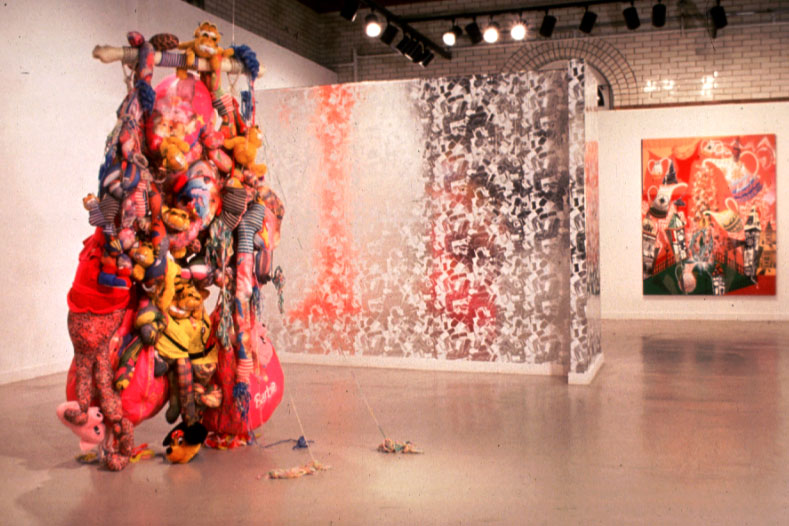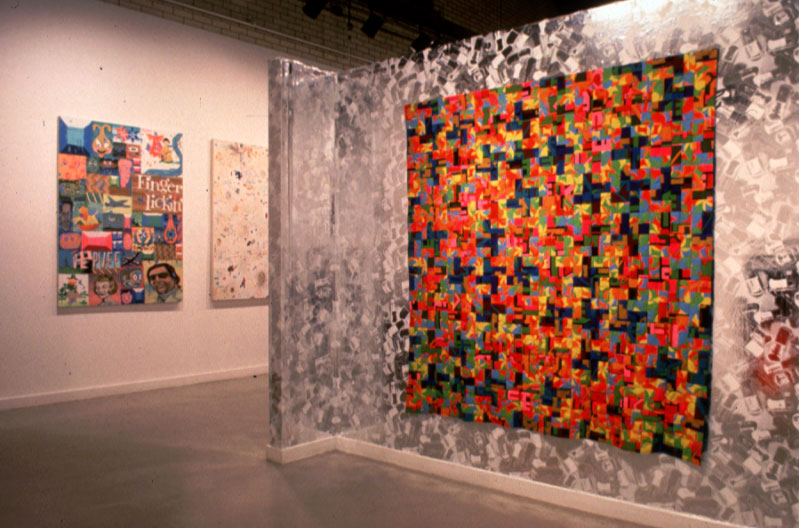November 7 – December 20, 1996
Beaver College Art Gallery
The Beaver College Art Gallery is pleased to present “Patterns of Excess,” a thematic exhibition for artists who embrace an aesthetic of visual complexity, from November 7 to December 20 in the Spruance Fine Arts Center on the campus.

Installation view, “Patterns of Excess,” Beaver College Art Gallery
Ingrid Schaffner, a well known New York critic, author, and independent curator, will present a lecture about the exhibition on Tuesday, November 19 at 6:30 PM in The Little Theater. A reception in the Art Gallery in honor of the speaker and exhibiting artists will immediately follow. Both events are free and open to the public..
“Patterns of Excess” includes painting and sculpture by ten artists: Carole Caroompas, Jim Isermann, Larry Mantello, Virgil Marti, Stuart Netsky, Lari Pittman, Christian Schumann, Jessica Stockholder, Lily van der Stokker, and Fred Tomaselli. The “patterns” invoked by the show’s title refer not merely to repetitive motifs, but to means of contruction that privilege additive processes such as accumulation, layering, and juxtaposition. Highly wrought, this work emphasizes its own physicality and is marked by intense color, surface density and compression, and the incorporation of “low” materials, with a predilection for glitz, kitsch, and references to consumer culture.
Often conjoining abstract and figurative elements, the work in this exhibition sets up a tension between representation and figuration. It is based in a transmuted decorative impulse, also indebted to Pop and Op art, that centralizes visual pleasure’s aesthetic and polemical value. It consciously pushes beyond simple formal and conceptual notions of the decorative, however, to deliver unexpected messages. For example, these works address the politics of sexuality, including gay survival and feminism (Caroompas, Netsky, Pittman); draw upon the realms of domestic craft and decor to parody prescribed forms of taste (Isermann, Marti); celebrate modes of juvenilia as icons of beauty and sentiment (Mantello, Schumann, van der Stokker); undermine pieties about the conflation of art and social life through poetically allusive assemblages (Stockholder), and allude to a liberated state still possible within the context of visual art (Tomaselli). The conscious extravagance of such work, its deliberate “impurity,” functions in effect and intent as a declaration against repressive aesthetic and socio-cultural practices, while always engaging and rewarding the viewer on a sensory level.

Installation view, “Patterns of Excess,” Beaver College Art Gallery
Caroompas, Isermann, and Pittman live in California; Mantello, Schumann, Stockholder, and Tomaselli live in New York; Marti and Netsky are from Philadelphia, and van der Stokker lives in Amsterdam. “This geographical diversity,” notes Gallery Director Paula Marincola, “attests to the widespread interest on artists’ part in this energetic and dynamic approach to artmaking. Such work compely a timely investigation.”
Ingrid Schaffner, who will lecture about the exhibition’s concept and artists, will also contribute an essay to its forthcoming catalogue. Schaffner has written extensively about contemporary art for Artforum, Art in America, Sculpture, Parkett, and Art & Antiques magazines. She has contributed essays to exhibition catalogues for several institutions including the Carnegie Museum in Pittsburgh, and the Solomon R. Guggenheim Museum in New York City. She recently wrote the catalogue essay for the Philadelphia Institute of Contemporary Art’s Jeanne Silverthorne show. Schaffner also has curated exhibitions such as “Richard Artschwager, Photo/Works 1945-1996,” “Like Young: Twelve New York Painters,” and received particular attention for “The Return of the Cadavre Exquis,” a show that involved contemporary artists in the collaborative surrealist drawing game of Exquisite Corpose, which originated at the Drawing Center in New York and traveled around the country. “Patterns of Excess” has been funded by the National Endowment for the Arts, a federal agency,the Pennsylvania Council on the Arts, and the Advisory Board and Friends of Beaver College Art Gallery.
